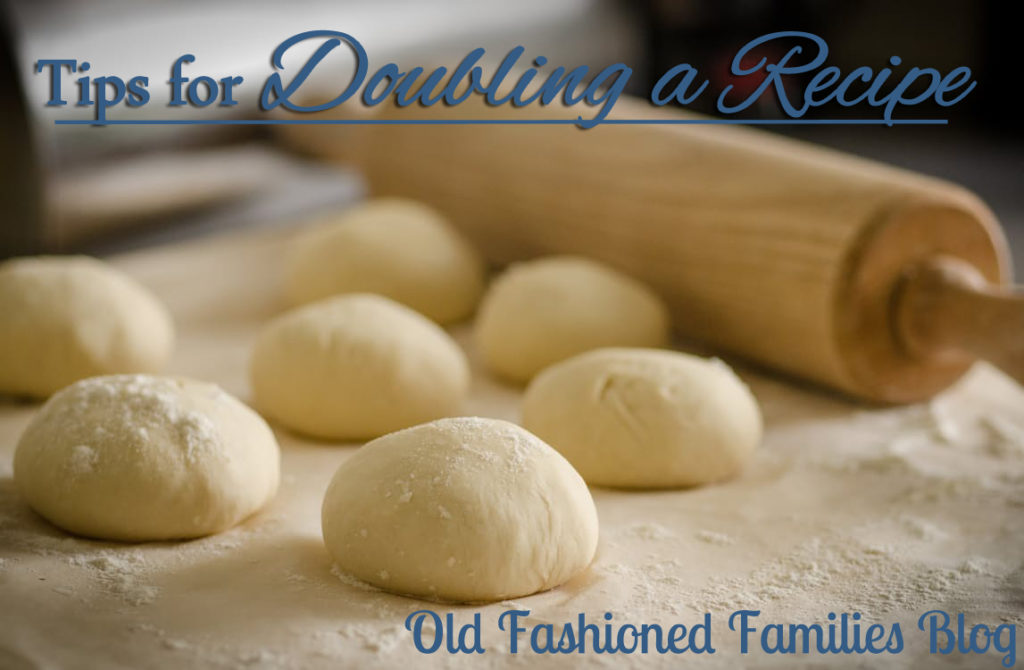Doubling a recipe is a great way to make things go a little further, prepare for a larger-than-normal crowd during the holidays, or simply have leftovers to reuse later. But, while you can just double everything, there are a few tips that will ensure that your recipe is a success!
Check it out below:
1. Not all recipes should be doubled
Generally speaking, the more complex the recipe, the harder it will be to double. With some things, you’re going to be better off to simply do two batches instead of a single double batch. Also, I don’t recommend you double a recipe that you’ve never made before.
2. Do the calculations before you start
Before you even begin to cook anything, sit down and convert all of the measurements on a piece of paper. That way you won’t have to be trying to do math and a million other things at once. I’ve included a cheat sheet below for your convenience! Some of the measurements (like 1/4) really don’t convert well to one and a half, so just use your judgment and add a little extra.
Original Doubled 1.25 1.5
1/4 tsp . . . . . . . . . . . 1/2 tsp . . . . . . . 1/3 tsp . . . . . . . . . 1/3 tsp
1/2 tsp . . . . . . . . . . . 1 tsp. . . . . . . . . . 2/3 tsp . . . . . . . . . 3/4 tsp
3/4 tsp . . . . . . . . . . . 1 1/2 tsp. . . . . . 1 tsp . . . . . . . . . . . 1 1/8 tsp
1 tsp . . . . . . . . . . . . . 2 tsp. . . . . . . . . 1 1/4 tsp . . . . . . . . 1 1/2 tsp
1 Tbsp . . . . . . . . . . . 2 Tbsp. . . . . . . . 1 Tbsp 1 tsp . . . . 1 Tbsp 1 1/2 tsp
1/4 cup . . . . . . . . . . 1/2 cup. . . . . . . . 1/3 cup . . . . . . . . . 1/3 cup (plus some extra)
1/3 cup . . . . . . . . . . 2/3 cup. . . . . . . . 1/3 cup . . . . . . . . . 1/2 cup
1/2 cup . . . . . . . . . . 1 cup . . . . . . . . . 2/3 cup . . . . . . . . . . 3/4 cup
2/3 cup . . . . . . . . . . 1 1/3 cup . . . . . 3/4 cup . . . . . . . . . 1 cup
3/4 cup . . . . . . . . . . 1 1/2 cup . . . . . 1 cup . . . . . . . . . . . . . 1 1/8 cup
1 cup . . . . . . . . . . . . . 2 cup . . . . . . . . 1 1/4 cup . . . . . . . . . 1 1/2 cup
3. Double some ingredients, but not all…
You’ll probably notice the above chart includes more than just doubling. That’s because while you’ll want to double the basic ingredients, there are some things you won’t want to double. Generally speaking, you should multiply herbs, salt, pepper, and alcohol by 1.5 and only multiply spicy ingredients by 1.25 so that you don’t overseason your dish. After all, you can always add more, but once it’s there, it’s there to stay! While you’ll want to double all fats that are mixed in cooking, if the recipe calls for olive oil or something similar to cook in a pan, you generally won’t need to double it.
4. Be precise
Cooking is at least partly a science, so when you’re doubling a recipe it’s extremely important to be as precise as possible. Some blogs will tell you to use a kitchen scale, but personally that’s a little too much work for me. Just make sure you’re actually measuring everything out when you double because there’s twice as much chance for things to go wrong.
5. Adjust your temperature appropriately
When you’re doubling a recipe, you will want to keep the same cook time as the recipe calls for, but increase your oven temperature by 25 degrees. Then, at the proper cooking time, start checking to see how much longer it needs. Remember that cooking with vary depending on the dish and other conditions, so pay attention!
Do you have any other tips for doubling a recipe? Tell me in the comments below!


Leave a Reply